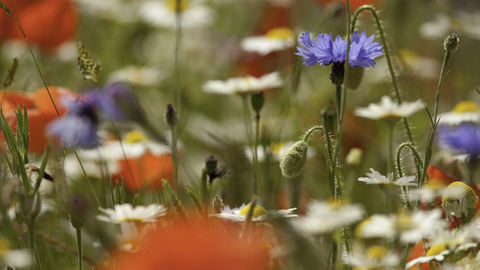
Wild flower meadow, Corn cockle, Corn flower, Centaurea montana, Agrostemma githago, Poppy, Papaver rhoeas, Sheffield - Paul Hobson
About the event
This two-day course is designed to give you confidence at identifying plants using botanical keys. In order to do so, this course will also give you a better understanding of botanical terms and flowering plant classification. You will then practise the ID skills you have learnt in the field.
Many of us know the names of very familiar plants such as buttercups or poppies. But trying to work out which buttercup or which poppy or the identity of other unfamiliar species can sometimes seem overwhelming. Picture-matching, although enjoyable, can sometimes be inconclusive or even, unwittingly, inaccurate.
Botanical keys focus on the important distinguishing features – the key features. Often these features are seen better with a hand lens. Using a botanical key is not rocket science. The process is logical, straight-forward and usually (with familiarity) quite rapid. It is also good fun – like a treasure hunt. What puts most people off is the prolific use of botanical terms. Even the simpler keys use at least some terminology, because one-word terms, avoid the use of long descriptive phrases. And above all the key aims to be concise.
Much of this course, especially on day one, will be devoted to understanding these botanical terms and how to interpret them in the context of identifying plants. We will start in the classroom, taking time to study each plant specimen carefully, at the same time as working our way through the keys to their identity. We will work as a group on specimens of the same species at any one time.
By day two you will spend more time practising outside, identifying the plants in Tyland Barn nature park. You will have plenty of opportunity to have a go on your own or working in pairs, but always under supervision.
Many of the key identification features are also the features that botanists use to classify plants into look-alike groups. This course will encourage you to appreciate the key characteristics of different ‘families’ (and ‘genera’). Recognising such characteristics provides short cuts in the process of using botanical keys.
By the end of the course it is expected that you will have gained:
- A working knowledge of relevant botanical terms
- An insight into flowering plant classification
- Greater confidence in using scientific keys to Identification, notably of plants
Led by Ros Bennett, Botanist
This course is suitable for beginners with no prior knowledge of floral structure or using scientific keys to ID as well as for improvers who know some plant species (or even several) but who struggle with using keys as a means of identifying those they don’t know
Booking
Price
Normal fee: £75 per person for this two-day course.Concessionary fee: Kent Wildlife Trust volunteers, senior citizens, unemployed and students £10 off.
Additional booking information
Other sites visited: Probably just the ‘nature park’, cottage garden and maybe some roadside verges around Tyland BarnPossibly KWT’s roadside verge nature reserve on the west side of the A229